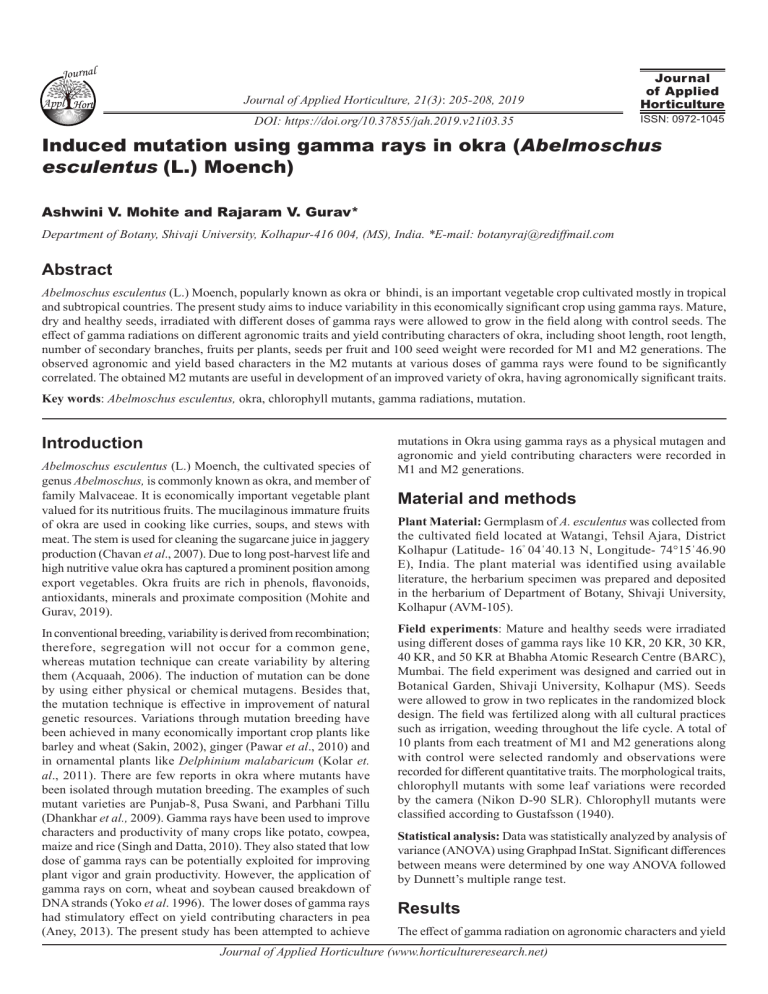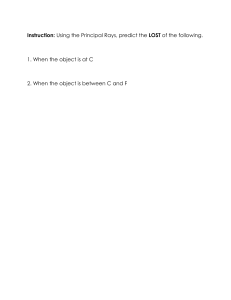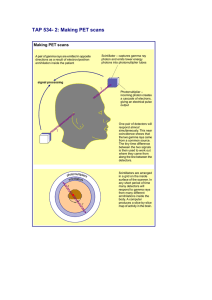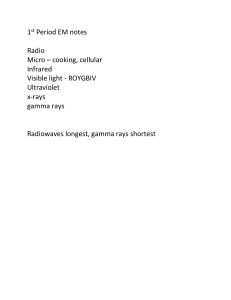
Journal Appl Journal of Applied Horticulture, 21(3): 205-208, 2019 Journal of Applied Horticulture DOI: https://doi.org/10.37855/jah.2019.v21i03.35 ISSN: 0972-1045 Induced mutation using gamma rays in okra (Abelmoschus esculentus (L.) Moench) Ashwini V. Mohite and Rajaram V. Gurav* Department of Botany, Shivaji University, Kolhapur-416 004, (MS), India. *E-mail: botanyraj@rediffmail.com Abstract Abelmoschus esculentus (L.) Moench, popularly known as okra or bhindi, is an important vegetable crop cultivated mostly in tropical and subtropical countries. The present study aims to induce variability in this economically significant crop using gamma rays. Mature, dry and healthy seeds, irradiated with different doses of gamma rays were allowed to grow in the field along with control seeds. The effect of gamma radiations on different agronomic traits and yield contributing characters of okra, including shoot length, root length, number of secondary branches, fruits per plants, seeds per fruit and 100 seed weight were recorded for M1 and M2 generations. The observed agronomic and yield based characters in the M2 mutants at various doses of gamma rays were found to be significantly correlated. The obtained M2 mutants are useful in development of an improved variety of okra, having agronomically significant traits. Key words: Abelmoschus esculentus, okra, chlorophyll mutants, gamma radiations, mutation. Introduction Abelmoschus esculentus (L.) Moench, the cultivated species of genus Abelmoschus, is commonly known as okra, and member of family Malvaceae. It is economically important vegetable plant valued for its nutritious fruits. The mucilaginous immature fruits of okra are used in cooking like curries, soups, and stews with meat. The stem is used for cleaning the sugarcane juice in jaggery production (Chavan et al., 2007). Due to long post-harvest life and high nutritive value okra has captured a prominent position among export vegetables. Okra fruits are rich in phenols, flavonoids, antioxidants, minerals and proximate composition (Mohite and Gurav, 2019). In conventional breeding, variability is derived from recombination; therefore, segregation will not occur for a common gene, whereas mutation technique can create variability by altering them (Acquaah, 2006). The induction of mutation can be done by using either physical or chemical mutagens. Besides that, the mutation technique is effective in improvement of natural genetic resources. Variations through mutation breeding have been achieved in many economically important crop plants like barley and wheat (Sakin, 2002), ginger (Pawar et al., 2010) and in ornamental plants like Delphinium malabaricum (Kolar et. al., 2011). There are few reports in okra where mutants have been isolated through mutation breeding. The examples of such mutant varieties are Punjab-8, Pusa Swani, and Parbhani Tillu (Dhankhar et al., 2009). Gamma rays have been used to improve characters and productivity of many crops like potato, cowpea, maize and rice (Singh and Datta, 2010). They also stated that low dose of gamma rays can be potentially exploited for improving plant vigor and grain productivity. However, the application of gamma rays on corn, wheat and soybean caused breakdown of DNA strands (Yoko et al. 1996). The lower doses of gamma rays had stimulatory effect on yield contributing characters in pea (Aney, 2013). The present study has been attempted to achieve mutations in Okra using gamma rays as a physical mutagen and agronomic and yield contributing characters were recorded in M1 and M2 generations. Material and methods Plant Material: Germplasm of A. esculentus was collected from the cultivated field located at Watangi, Tehsil Ajara, District Kolhapur (Latitude- 16° 04ˈ40.13 N, Longitude- 74°15ˈ46.90 E), India. The plant material was identified using available literature, the herbarium specimen was prepared and deposited in the herbarium of Department of Botany, Shivaji University, Kolhapur (AVM-105). Field experiments: Mature and healthy seeds were irradiated using different doses of gamma rays like 10 KR, 20 KR, 30 KR, 40 KR, and 50 KR at Bhabha Atomic Research Centre (BARC), Mumbai. The field experiment was designed and carried out in Botanical Garden, Shivaji University, Kolhapur (MS). Seeds were allowed to grow in two replicates in the randomized block design. The field was fertilized along with all cultural practices such as irrigation, weeding throughout the life cycle. A total of 10 plants from each treatment of M1 and M2 generations along with control were selected randomly and observations were recorded for different quantitative traits. The morphological traits, chlorophyll mutants with some leaf variations were recorded by the camera (Nikon D-90 SLR). Chlorophyll mutants were classified according to Gustafsson (1940). Statistical analysis: Data was statistically analyzed by analysis of variance (ANOVA) using Graphpad InStat. Significant differences between means were determined by one way ANOVA followed by Dunnett’s multiple range test. Results The effect of gamma radiation on agronomic characters and yield Journal of Applied Horticulture (www.horticultureresearch.net) 206 Induced mutation using gamma rays in okra contributing characters were observed in M1 and M2 generations (Table 1 and 2). In M1 generation, germination percentage was reduced in all the doses of gamma rays than the control. Shoot length, root length, the number of secondary branches, the number of nodes and the number of fruits per plant increased in 50 KR concentrations. The number of seeds per fruit was highest for 20 KR i.e. 79.30±8.87 and lowest for 50 KR, i.e. 62.00±14.76. The weight for 100 seeds was highest for 40 KR (5.71 g) followed by for 30 KR (5.68 g) (Table 1). Chlorophyll mutants were observed in M1 generation for 40 KR and 50 KR and these were Yellow Viridis, Albina green, Clorina and Striata. Different types of leaf morphological changes were also observed (Fig.1). As in M1 generation, somewhat similar kind of observations for agronomic and yield based characters were recorded in M2 generation (Table 2). Agronomic and yield characters varied with different doses of gamma rays in M2 generation. Shoot length, number of nodes and number of fruits per plant were found to be highest for 50 KR. Number of secondary branches was highest for 40 KR (2.5) followed by 50 KR (2.4). The number of seeds per fruit was highest for 10 KR (84.30) and lowest for 50 KR (60.00). The weight of 100 seeds was highest for 20 KR which was similar to the control (4.79 g) (Table 2). Discussion All the doses of gamma rays caused variation in agronomic and yield characters in both M1 and M2 generations. The number of chlorophyll mutants increased along with increased dose of gamma rays. These observations indicated that gamma rays are effective for the induction of chlorophyll mutants. Similar results were recorded in common bean (Ulukapi and Ozmen, 2017). Chlorophyll mutants viz. albino and leaf variations in musk okra were also reported by Warghat et al. (2011). In the present investigation, all the characters showed the stimulatory result with an increased dose of gamma radiation. Shoot length and root length were highest with an increased dose of gamma radiations as compared with control. Shoot and root length were found to be higher in both the generations when compared with the value reported by the Hegazi and Hamideldin (2010), i.e., 81.08 to 116.38 cm in okra. In the present investigation, effect of gamma radiation on yield characters like number of fruits per plant, number of seeds per fruit and 100 seed weight were in agreement with the values reported by Surendran and Udayan (2017) in okra. Ullah et al. (2014) reported higher number of fruits per plant and seeds per fruit which ranged from 6.6 to 10.2 and 178.5 to 414.3, respectively. Gamma rays treatment-induced mutation in the agronomically important traits, which stimulates the morphological and yield attributing characters. In addition, observed agronomically important characters were found stable in mutants of both M1 and M2 generation. The present investigation highlighted that the gamma-ray is a suitable physical mutagen for the induction of variability in both M1 and M2 generations. The treated plants were found to be superior when compared to untreated plant on the basis of yield and yield contributing characters. The obtained M2 mutants are needed to be improved further through breeding practices to develop new economically important variety of okra. References Acquaah G. 2006. Principles of Plant Genetics and Breeding. Chichester: Wiley-Blackwell. Aney A. 2013. Effect of gamma irradiation on yield attributing characters in two varieties of pea (Pisum sativum L.). Int. J. Life Sci., 1(4): 241-247. Table 1. Effect of gamma rays on agronomic and yield characters of okra in M1 generation Parameters Germination (%)a Shoot length (cm) Root length (cm) Number of secondary branches Number of nodes Length of internodes (cm) range Number of fruits / plant Number of seeds / fruits 100 seed weight (g) Control 36.17±9.50 113.35±17.95 25.42±5.67 0.3±0.91 11.20±1.93 8.44±1.90 4.60±2.01 76.30±9.06 5.13±0.14 10 KR 30.00±14.00 125.22±11.45ns 26.81±5.29ns 1.6±0.96* 10.80±1.87ns 10.72±1.13* 8.00±3.74ns 77.00±6.54ns 5.31±0.37ns 20 KR 35.29±9.00 133.30±10.96* 27.70±3.90ns 0.9±0.80ns 10.5±2.06ns 12.15 ±2.22** 5.80±1.68ns 79.30±8.87ns 5.61±0.35ns 30 KR 34.11±2.00 148.00±13.93** 27.35±3.59ns 1.3±0.82ns 13.00±0.82ns 10.49±1.49 ns 8.50±3.56ns 76.30±9.59ns 5.68±0.34* 40 KR 29.41±7.00 156.15±13.61** 29.00±5.89ns 1.2±0.63ns 10.7±2.31ns 12.81±1.48** 11.30±4.05** 74.00±7.73ns 5.71±0.35* 50 KR 32.94±11.00 173.40±28.50** 36.20±5.64** 3.3±1.88** 17.90±6.99** 9.33±2.59ns 14.30±5.86** 62.00±14.76** 5.60±0.72ns Values were presented in mean ± S. D. (N=10), ns- non significant, * significant at P < 0.05, **significant at P < 0.01.a- Germination (%) values in mean ± S.E. (N=2). Table 2. Effect of gamma rays on agronomic and yield characters of okra in M2 generation Parameters Shoot length (cm) Root length (cm) Number of secondary branches Number of nodes Length of internodes (cm) Range Number of fruits / plant Number of seeds / Fruits 100 Seed weight (g) Control 205.7±51.28 26.87±4.78 1.1±1.01 17.80±2.89 11.51±1.19 8.50 ± 4.08 77.70±10.84 4.79±1.01 10KR 203.5±29.24ns 29.75±2.48ns 20 KR 209.7±22.12ns 32.34±6.07* 30 KR 206.3±23.85ns 32.59±1.64* 40 KR 208.2±24.89ns 26.62±3.21ns 50 KR 221.3±39.67ns 28.68±4.30ns 0.4±0.84ns 17.10±2.46ns 11.08±1.38 ns 6.00 ± 3.46 ns 84.30±9.38 ns 4.71±0.61 ns 0.0±0.00ns 15.70±1.49ns 11.61±1.30 ns 6.50 ± 1.64 ns 67.10±10.51 ns 4.79±0.75 ns 0.4±1.26ns 17.70±3.05ns 16.60±1.36 ns 6.30 ± 1.33 ns 73.70±10.34 ns 4.44±0.76 ns 2.5±2.46ns 16.60 ±3.16ns 11.28±1.50 ns 7.70 ± 2.83 ns 75.00±26.89 ns 4.70±1.03 ns 2.4±1.71ns 19.00±2.78ns 10.22±1.14 ns 8.60 ± 3.27 ns 49.50±14.36** 4.62±0.60 ns Values were presented in mean ± S. D. (N=10), * Correlation significant at P < 0.05 level, **Correlation significant at P < 0.01 level. Journal of Applied Horticulture (www.horticultureresearch.net) Induced mutation using gamma rays in okra Fig. 1. Chlorophyll mutants and leaf variation in okra. A: Control, B: Yellow Viridis, C: Strita, D: Albina Green, E and F: Clorina, G to J: Leaf morphological variations, Scale bar = 4 cm. Journal of Applied Horticulture (www.horticultureresearch.net) 207 208 Induced mutation using gamma rays in okra George, A. 2007. Mutagenesis in plant breeding In: Principles of Plant Genetics and Breeding. Blackwell publishing. pp. 199-213. Chavan, J.K., U.S. Dalvi, and U.D. Chavan, 2007. Isolation of lady’s finger (okra) stem mucilage as clarificant in jaggery preparation. J. Food. Sci. Tech., 44(1): 59-61. Dhankhar, B.S., R. Singh, R. Kumar and S. Kumar, 2009. Genetic Improvement In: Okra Handbook: Global Production, Processing and Crop Improvement. HNB Publishing, pp. 125-158. Gustafsson, A. 1940. The mutation system of the chlorophyll apparatus. Lunda Guv. Asskr. M. F. Adv., 2(11): 1-40. Hegazi, A.Z. and N. Hamideldin, 2010. The effect of gamma irradiation on enhancement of growth and seed yield of okra [Abelmoschus esculentus (L.) Monech.] and associated molecular changes. J. Hort. Forest., 2(3): 38-51. Kolar, F., N. Pawar and G. Dixit, 2011. Induced chlorophyll mutations in Delphinium malabaricum (Huth) Munz. J. Appl. Hort., 13(1): 18-24. Mohite, A.V. and R.V. Gurav, 2019. Nutraceutical and antioxidant evaluation of Abelmoschus taxa. Int. J. Veg. Sci. https://doi.org/10. 1080/19315260.2019.1597801. Pawar, N., S. Pai, M. Nimbalkar, F. Kolar and G. Dixit, 2010. Induction of chlorophyll mutatnts in Zingiber officinale Roscoe by gamma rays and EMS. Emir. J. Food Agric., 22(5): 406-411. Sakin, M.A. 2002. The use of induced micro-mutations for quantitative characters after EMS and gamma rays treatments in Durum wheat breeding. Pak. J. App. Sci., 2(12): 1102- 1107. Singh, B. and P.S Datta, 2010. Effect of low dose gamma irradiation on plant and grain nutrition of wheat. Radiat. Phys. Chem., 79: 819–825. Surendran, S. and P.S. Udayan, 2017. Gamma rays induced mutations on morphological and yield attributing characters in M2 generation of okra [Abelmoschus esculentus (L.) Monech.]. Int. J. Curr. Microbiol. App. Sci., 6(10): 3623- 3628. Ullah, H., R.U. Khan, S.U. Khan, S. Mehmood, S.K. Sherwani, A. Muhammad, S.A. Gilani, H. Ullah and Y. Muhammad, 2014. Estimation of induced variability of yield contributing traits in M1 gamma irradiated germplasm of Okra (Abelmoschus esculentus L.). South Asian J. Life Sci., 2(1): 4-7. Ulukapi, K. and S.F. Ozmen, 2017. Study of the effect of irradiation (60Co) on M1 plants of common bean (Phaseolus vulgaris L.) cultivars and determined of proper doses for mutation breeding. J. Rad. Res. App. Sci., XXX: 1-5. Warghat, A.R., N.H. Rampure and P. Wagh, 2011. Effect of sodium azide and gamma rays treatments on percentage, germination, survival, morphological variation and chlorophyll mutation in musk okra (Abelmoschus moschatus L.). Int. J. Phr. Phrm. Sci., 3(5): 483-486. Yoko, K., M. Aya, I. Hiromi, Y. Takashi and S. Kukio, 1996. Effect of gamma irradiation on cereal DNA investigated by pulsed-field gel electrophoresis. Shokuhin-Shosha, 31: 8-15. Received: May, 2019; Revised: May, 2019; Accepted: June, 2019 Journal of Applied Horticulture (www.horticultureresearch.net)



